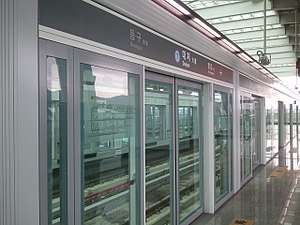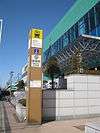Daejeo station
Daejeo Station is a station of the Busan Metro Line 3 and BGLRT Line located in Daejeo-dong, Gangseo District, Busan, South Korea. It is a southern terminus of Line 3 at this station. During the construction, the Line 3 Station was known as Jungni Station, and Busan-Gimhae Light Rail Station known as Seoyeonjeong Station.
Daejeo | |||||||||||
|---|---|---|---|---|---|---|---|---|---|---|---|
| Korean name | |||||||||||
| Hangul | |||||||||||
| Hanja | |||||||||||
| Revised Romanization | Daejeoyeok | ||||||||||
| McCune–Reischauer | Taejŏyŏk | ||||||||||
| General information | |||||||||||
| Location | Daejeo-dong, Gangseo District, Busan South Korea | ||||||||||
| Coordinates | 35°12′48.1″N 128°57′39.6″E | ||||||||||
| Operated by | Busan Transportation Corporation | ||||||||||
| Line(s) | Line 3 | ||||||||||
| Platforms | 1 | ||||||||||
| Tracks | 2 | ||||||||||
| Construction | |||||||||||
| Structure type | Aboveground | ||||||||||
| Other information | |||||||||||
| Station code | 317 | ||||||||||
| History | |||||||||||
| Opened | November 28, 2005[1] | ||||||||||
| Previous names | Jungri (before opening) | ||||||||||
| Services | |||||||||||
| |||||||||||
Daejeo | |||||||||||
|---|---|---|---|---|---|---|---|---|---|---|---|
 Daejeo LRT platform | |||||||||||
| Location | Daejeo-dong, Gangseo District, Busan South Korea | ||||||||||
| Coordinates | 35°12′47.15″N 128°57′37.8″E | ||||||||||
| Operated by | Busan–Gimhae Light Rail Transit Operation Corporation | ||||||||||
| Line(s) | Busan–Gimhae Light Rail Transit | ||||||||||
| Platforms | 2 | ||||||||||
| Tracks | 2 | ||||||||||
| Construction | |||||||||||
| Structure type | Aboveground | ||||||||||
| Disabled access | Yes | ||||||||||
| Other information | |||||||||||
| Station code | 7 | ||||||||||
| History | |||||||||||
| Opened | September 16, 2011[2] | ||||||||||
| Previous names | Seoyeonjeong (before opening) | ||||||||||
| Services | |||||||||||
| |||||||||||
Station Layout
| L2 Platforms |
Side platform, doors will open on the right | |
| Southbound | ← Busan-Gimhae LRT toward Sasang (Deunggu) | |
| Northbound | → Busan-Gimhae LRT toward Kaya University (Pyeonggang) → | |
| Side platform, doors will open on the right | ||
| L1 | Concourse | Faregates, Shops, Vending machines, ATMs, Link to Line 3 station |
| G | Street Level | Exits |
| L1 | Concourse | Faregates, Shops, Vending machines, ATMs, Link to BGL station |
| L2 Platforms |
Southbound | ← Line 3 toward Suyeong (Sports Park) |
| Island platform, doors will open on the left | ||
| Northbound | → Line 3 Alighting Passengers Only or toward Daejeo Depot → | |
Exits
| Exit No. | Image | Destinations |
|---|---|---|
 |
GS25 Beomeo Station Bus Stop | |
| Daejo Line 3 station | ||
 |
Bus Stop | |
| Daejo BGL station |
gollark: trust in rust
gollark: Rtryuuuusturuyyryysyt.
gollark: Add <@509849474647064576> or else.
gollark: GNU/Monads also have to be applicatives and functors.
gollark: I'd just like to interject for a moment. What you’re referring to as Monad, is in fact, GNU/Monad, or as I’ve recently taken to calling it, GNU plus Monad. Monad is not an operating system unto itself, but rather another free component of a fully functioning GNU system made useful by the GNU corelibs, shell utilities and vital system components comprising a full OS as defined by POSIX. Many computer users run a modified version of the GNU system every day, without realizing it. Through a peculiar turn of events, the version of GNU which is widely used today is often called “Monad”, and many of its users are not aware that it is basically the GNU system, developed by the GNU Project. There really is a Monad, and these people are using it, but it is just a part of the system they use. Monad is the kernel: the program in the system that allocates the machine’s resources to the other programs that you run. The kernel is an essential part of an operating system, but useless by itself; it can only function in the context of a complete operating system. Monad is normally used in combination with the GNU operating system: the whole system is basically GNU with Monad added, or GNU/Monad. All the so-called “Monad” distributions are really distributions of GNU/Monad.
References
- Sohn, Yeongsin (2005-11-28). 부산 지하철 3호선 개통 [Open the Busan Metro Line 3]. Busan.com (in Korean). Busan: Busan Ilbo. Retrieved 2014-02-13.
- Kim, Seonho (2011-09-16). Jeong, Ayeon (ed.). 부산~김해 경전철 개통식..17일부터 영업운행 [The opening of Busan–Gimhae Light Rail Transit, start from 17th]. Naver (in Korean). Busan: Yonhap News. Retrieved 2014-02-13.
External links
- Cyber station information, Line 3 from Busan Transportation Corporation (in Korean)
- Cyber station information, BGLRT Line from Busan Transportation Corporation (in Korean)
| Wikimedia Commons has media related to Daejeo Station. |
This article is issued from Wikipedia. The text is licensed under Creative Commons - Attribution - Sharealike. Additional terms may apply for the media files.